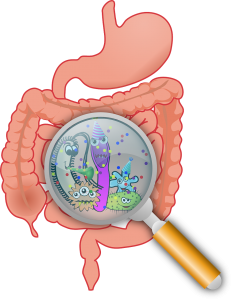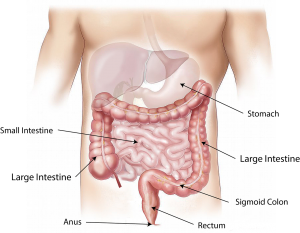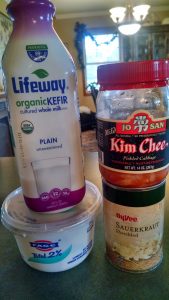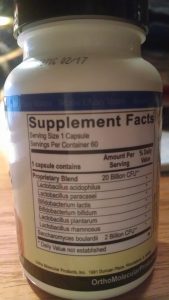What would you like to see packaged up in a box under your Christmas tree this year?

This is a beautiful tree we bought locally at Birch Meadow Farm Christmas Trees (as we do every year) from a wonderful couple that own it, Burt & Loretta Barton.
I will take a bet that having “good gut bugs” is not on your list! But they should be! For the scientific world is really in the infant stages of discovering all of the health benefits of having a healthy microbiome (all of the microbes that live within us all) with connections to obesity, respiratory diseases, brain disorders, gastrointestinal diseases, autoimmune diseases, and the list keeps growing daily! So after giving you this speedy primer on what “good gut bugs” can do for health, you will have the educational foundation to start acquiring these immune boosting bacteria, without even having to ask Santa!

To help us along this journey, I have referenced three experts that were our recent guests on radio show “Healthy U”: Dr. Justin Sonnenburg, assistant professor in the Department of Microbiology and Immunology at Stanford University of Medicine and his wife Dr. Erica Sonnenburg, senior research scientist at Stanford University of Medicine, co-authors of The Good Gut, and Dr. Brett Finlay, Professor at the University of British Columbia, international leader on bacterial infections, co-author of Let Them Eat Dirt. With additional reference to Dr. David Perlmutter, neurologist, Fellow of the American College of Nutrition and recipient of the Linus Pauling Award, author of Brain Maker.
First, the compelling reason we all need to take the health of our gut bacteria seriously: The majority of your immune system is found in the gut, and it communicates with your intestinal bacteria! You see, roughly 100 trillion bacteria are alive and well, predominantly in our “gut” home. Putting that in an astronomic measure: if you lined up your bacteria, end to end, it would reach the moon!

First, let’s get some definitions down:
I. Gut Chalkboard Definitions:
A. Gut-When I reference “gut” I am predominantly talking about the large intestine. Roughly 10 to the 14th amount of microbes resides in our entire body, but about 10 to the 13th of that amount harbors in our intestinal flora. Because of the acidic environment that food travels through in our bodies, all the way from the esophagus to the beginning of the small intestine, bacteria don’t find a real home. When your food arrives at the small intestine, there is a modest amount of those bacteria, about 50 million per teaspoon, but not to be outdone, when food arrives at the large intestine, 500 billion microbial cells per teaspoon is the count!

B. Microbiome– just like skin is an organ that covers the body, so too, you need to think of your microbiome as an organ that weighs roughly 2 pounds of our body weight. The microbiome is the term used for the collective amounts of microbes living within us, which would include all our own special microbiota consisting of bacteria, viruses and fungi. So for every human cell in our bodies, there are 10 microbes. But just to make you feel even more special, each one of your microbes has it’s own snowflake fingerprint (remember not one snowflake is identical to the next) genetic code!

So what does the microbiome do for us? Let me count the ways!!!:
II. Microbiome Function-
A. Helps fight off harmful bacteria.
B. Assists in digesting our food.
C. Trains the immune cells to respond.
D. Protects the gut barrier.
E. Helps control inflammation. Note that inflammation is the beginning point of all chronic disease!
F. Assists in producing important chemicals for brain health.
G. Metabolizes energy:
Think of the intestine as a bioreactor where bacteria ferment fiber, carbohydrates, and protein that were not digested and absorbed in the small intestine. The end products of this process are called short-chain fatty acids (SCFA) and three of them are very important to different aspects of human energy metabolism-acetate, butyrate and propionate-Let Them Eat Dirt.
Note that these short-chain fatty acids are not only absorbed for energy but they also serve the dual purpose of protecting the gut from inflammation!
Notice that this list is just the beginning of what science is discovering about what the microbiome organ does for you! There will definitely be more to come in the near future!!!
Just know that the reason, first and foremost, I’m taking the time to share this information with you is to let you know that YOU have the power, primarily through your diet, to play your best hand of genetic cards in keeping your microbiome humming at it’s optimum potential, so that you can live a quality lifespan!!!
Okay, you might say: “What does that have to do with me? My gut is humming along just fine!”
Well, maybe or maybe not, but first the “why” of compromised gut health:
III. Cracks in the Microbiome-
A. Leaky Gut Syndrome-Picture your microbiome as a totally enclosed tiled bathroom with grout to seal the tiles:

Got the picture? That grout is made of protein with our actual intestinal wall only 1 cell thick! The grout in our intestinal wall has the consistency of mucus and has to cover the inside of our 30 foot intestine with the equivalent surface area of mucus coverage of an entire floor of a 2,000 square foot house! So when our bacteria get out of whack, it make the protein grout porous and releases unwelcome proteins from the gut walls into the bloodstream and sets up an immune response that leads to inflammation. And what is the reason for that intestinal permeabilty? Ingredients like gluten in the diet, pathogenic bacteria, medications like antibiotics, elevated blood sugar and environmental toxins, just to name a few. The fall-out of this leaky gut syndrome is associated with IBD, Celiac disease, brain disorders, and the list goes on!
B. Less Microbiota Diversity-We truly have a symbiotic relationship with our microbes. We feed our microbes through our diet and the microbes, in return, (might as well think of them as our gut relatives!) break down our food into the molecules we need for our gut immune system. But what we need is a diverse amount of gut bacteria for our microbiota to thrive:
Diversity matters. In an ecosystem like that of the gut, diversity can be a buffer against system collapse. As diversity is lost in the Western microbiota, this ecosystem is at greater risk of collapse-a collapse that could affect the health of the human hosting the flailing ecosystem-The Good Gut.
The rub came in when we changed our diet from the hunter-gatherer diet (witness the African Hazda diet, consuming 100-150 grams of fiber per day), rich with fiber to the Western, low-fiber (estimated at 10-15 grams of fiber per day) processed diet. The Western diet relies on three basic plants that provide roughly 60% of their calories: rice, corn and wheat. So along with our low-fiber McDonald’s type diet that has decreased our microbiota diversity, add to that our overuse of antibiotics (antibiotics act like a forest fire to our microbiome, temporarily annihilating good and bad gut bacteria) and our sanitizer-happy ways and we are in a world of microbe hurt!

Now let’s explore some scientific studies associating either leaky gut or lack of microbiota diversity or both with our health:
IV. Just the Facts Ma’am!!-
A. Obesity- Obesity causes an inflammatory state which in turn is a known precursor to most chronic diseases. But it’s now found to also have a gut connection. In a 2013 Danish study published in Nature, two groups of roughly 300 Danish individuals’ microbiome were studied. One group has a “rich” microbiome containing many genes and a diversity of microbes. The other group had a “poor” microbiome, lacking microbe diversity and genes. The “rich” group had greater amounts of anti-inflammatory bacterial species and were thinner. The “poor” group had greater inflammatory associated bacteria, higher insulin resistence, their procarcinogenic metabolic potential (think cancer, Type II diabetes and cardiovascular disease) was greater and they were heavier.
And if you think the microbiome quality has nothing to do with obesity, think twice. Dr. Jeff Gordon of Washington University School of Medicine performed groundbreaking experiments on mice where the germ free mice (who normally have 40% less fat than normal mice) were colonized with the feces of obese mice, with no changes to their nourishment:

Guess what? Those colonized germ-free mice gained significantly more weight than even normal mice. The theory being that the obese mice’s microbiome is more efficient at harnessing energy from food than their “thin” counterpart.
And a nod to obesity associated with antibiotic use (remember antibiotics are like a brush fire to those gutbugs, good and bad in your microbiome). Just look at your farm animals that are our food source: 10-15% of their weight gain is attributable to antibiotics. And the same goes for humans: In a 2015 study published in the International Journal of Obesity of roughly 163,000 kids between the ages of 3-18 years. There were a direct correlation for kids at any age taking antibiotics and weight gain:
“Your BMI may be forever altered by the antibiotics you take as a child,” says study leader Brian S. Schwartz, MD, MS, a professor in the Department of Environmental Health Sciences at the Bloomberg School. “Our data suggest that every time we give an antibiotic to kids they gain weight faster over time.”
B. Allergies – According to a study by the CDC, food allergies have increased 50% between 1997-2011. A study in the New England Journal Medicine, studying peanut allergies, points to the solution to this problem. The old adage of avoiding all allergens in the first year of life is getting thrown out the microbiome door!!! By introducing allergenic foods early in life, (between 4-7 months), you are encouraging immune tolerance to your gastrointestinal immune system, A/K/A your microbiome. Once introduced, allergenic foods should keep being introduced, early and often to prevent allergies!
C. Brain Disorders- Brain disorders are the most insidious but silent disease/disabler of our times. Case in point, Alzheimer’s:
To date there is no drug that can totally arrest the devastating disease of Alzheimer’s, the most common form of dementia. Worldwide, nearly 44 million people have Alzheimer’s or a related dementia, yet only 1 in 4 have been diagnosed. Alzheimer’s and other dementias have the unfavorable distinction of being the top cause of disabilities later in life-See: How To Protect Your Brain With Simple Lifestyle Changes.-
What we can do is be aware of what might be causing these brain disorders and then do everything in our lifestyle tool chest to avoid them.
1. Brain-Derived Neurotrophic Factor (BDNF)-This is a critical brain-growth protein, necessary for creating new neurons, protecting existing neurons and stimulating synapses or brain connections. Decreased levels of BDNF are associated with a host of neurological conditions, i.e. epilepsy, anorexia nervosa, Alzheimer’s and obsessive-compulsive disorder. BDNF can be increased with Omega 3 consumption of DHA, aerobic exercise and the latest BDNF booster is a healthy balance of gut bacteria! Dr. David Perlmutter, neurologist and author of Brain Maker points to a study published in a 2013 journal of JAMA Neurology , culled from the Framingham Heart Study, looking for BDNF blood levels of 2,131 adults. These adults of were followed for 10 years, and free of dementia at the start.
What the Boston University researchers found was that those individuals at the beginning of the study who had the highest levels of BDNF had less than half the risk of dementia compared to those with the lowest BDNF. The researchers concluded “Our findings suggest a role for BDNF in the biology and possibly in the prevention of dementia and Alzheimer’s”-Brain Maker
2. Lipopolysaccharide (LPS)-This is a major component of the outer membrane of certain bacteria, composed of fats and sugar, and has the (villainous) ability to flip on inflammatory pathways in the body, representing 50-70% of the intestinal flora. It’s a good guy when it’s doing what it’s supposed to do, like protecting bacteria from being digested from gall-bladder bile salts. However, when the gut is compromised, as in Leaky Gut Syndrome (remember that protein grout that is porous?), LPS gets into the bloodstream, fueling inflammation and inflicting brain disorders in it’s path.
All three of the graphs below show an association with high levels of LPS and the brain disorders of Alzheimers, ALS (Lou Gehrig’s Disease) and Depression:
- Alzheimer’s & LPS levels
- ALS & LPS levels
- Depression & LPS levels
All graphs are from Dr. Perlmutter’s book Brain Maker .
The absolute good news for you is that you CAN nurture your newly-found relative that really does so much for you, your microbiome!:
V. Microbiome Nurturing Plan-
A. Start with Birth and Breastfeeding- Natural birth is best when it comes to getting the most microbial bang for your new baby’s buck! Besides following the diet suggestions I outline below to ramp up the healthy microbes of your microbiome to your baby, a vaginal birth covers your baby with healthy vaginal and (yes) fecal secretions, that makes a positive microbial impact on your baby’s new microbiome. However, vaginal births are not always possible. C-section babies do not have the skin microbes specific to the mother that vaginal babies have, so the baby does not inherit the bacterial community of a vaginally delivered baby. They inherit a less than ideal collection of bacteria. There is a suggestion by some scientists that vaginally swabbing the mother at birth, then inoculating the newborn in multiple body sites is a thought to maximize those golden microbes from mom. To date this is not scientifically proven but I believe it is theoretically sound!
Natural is also better in maximizing those gut microbiota when it comes to feeding your newborn. Studies from Complutense University of Madrid suggest that mother’s milk includes bacteria from mother’s microbiome:
A major source for bacterial colonization of the infant gut is through bacteria in the mother’s milk, and it has been proposed that this mode of colonization plays a major role in the child’s health status.
B. Eat Some Dirt!- When it comes to circumventing childhood allergies and asthma, science bears it out that living on a rural farm is best! Playing in the dirt (that includes poop), being exposed to animals and just in general playing outside stimulates the immune system!

By living in a more sterile environment, where outside play (yes in the dirt) with animals is not the norm, kid’s immune systems don’t have the same chance to mature, setting up a possible hyperactive immune system that later develops into asthma, or allergies. Dr. Mark Holbreich, allergist, treated the North American Amish for 20 years, noting the incidence of allergies and asthma. Note that the Amish live a technology-free life, enjoying life on the farm, with lots of DIRT! Their 5% incidence of asthma was comparable to rates generations ago!
C. Ditch McDonalds and Go For MACs! MACs stands for microbiota accessible carbohydrates and include a diet rich in fibrous fruits, vegetables, legumes, ancient grains and throw in a little dark chocolate too. MACs are the best foods to maximize your production of short-chain fatty acids, that ramps up your energy metabolism and protects your microbiota from inflammation. MACs include foods that are probiotic and prebiotic. Prebiotic foods stimulate the growth of healthy bacteria but are strictly short-term visitors of the gut because of their nondigestible qualties. They include asparagus, Jerusalem artichokes, the entire allium family (onions, garlic, leeks, green onions, shallots), bananas and wheat bran.
- Prebiotic-Onions
- Prebiotic-Garlic
- Prebiotic-Asparagus, Leeks & Artichokes
Probiotics are fermentable foods that actually re-inoculate the gut with quality microbes to keep the microbiome humming! Probiotics are usually fermented foods like Kimchi (See: SUPERFOOD RECIPES: Gut Health Foods for a recipe to make your own carrot or cabbage Kimchi), yogurt, Kefir, sauerkraut and miso. Fermented foods serve two functions: they reduce the sugar content of foods and they interact with the gut and microbiota. They too are only transient visitors to the gut, but they have such a powerfully positive impact to the microbiome in the form of increased immune boosting. You’ve got to make them a daily part of your diet! This is a pic of my favorites probiotics. Note that I’ve already eaten half the jar of Kimchi, I love it!:

Just make sure “live active cultures” is stated on the yogurt you buy, with no added sugar:

D. Antibiotics with Probiotics- Only take antibiotics as a last resort, not a knee-jerk reaction to an infection. I can speak personally on this subject. Our son and two daughters had chronic ear infections. That was close to thirty years ago. Back then I remember having all three of our kids on continuous rounds of antibiotics to clear up their ear infections and it took forever (it seems like) for them to get over their infections. No wonder though! Now that I look back on it, their immune systems were down because their microbiota was torched!! As I mentioned before, antibiotics are like a forest fire to the good and bad gut bugs you’ve established in your microbiota. Your microbiome temporarily will not be performing at it’s peak immune boosting self until it re-establishes those good bacteria. My suggestion if antibiotics are required? Take probiotics with antibiotics. I usually recommend taking the food-source of probiotics before taking supplements. However, in this case, supplemental probiotic is a good idea because you know exactly what you’re getting. Each daily serving should have 20 Billion CFU (or Colony Forming Units) with a cacophony of Lactobacillus and Bifidobacterium varieties.

Also, do not consume the probiotic until 1-2 hours after the antibiotic for maximum gut efficiency.
E.Lifestyle Rules!!!- Having all components of a healthy lifestyle is important for not only your overall health, but of course, your gut health too! We’ve talked about nutrition, but don’t forget daily movement and recovery in the form of quality sleep and a healthy stress response! Need ideas? Check out: A Perfect Day in the Game of Life.
Recap of :
All I Want For Christmas Is Some Good Gut Bugs!!
I. Gut Chalkboard Definitions
A.Gut
B. Microbiome
II. Microbiome Function
III. Cracks in the Microbiome
A. Leaky Gut Syndrome
B. Less Microbiota Diversity
IV. Just the facts ma’am!!
A. Obesity
B. Allergies
C. Brain Disorders
V. Microbiome Nurturing Plan
A. Start with Birth and Breastfeeding
B. Eat Some Dirt!
C. Ditch McDonalds and Go For MACs!
D. Antibiotics with Probiotics
E. Lifestyle Rules!!!
Now a special holiday breakfast treat full of MACs A/K/A microbiota accessible carbohydrates! It doesn’t have to taste bad to be good for you! I promise, this easy-to-prepare breakfast will not only satisfy your tastebuds but will keep you going until lunch time (or beyond). PLUS, it will feed all of your good gut bugs! Best breakfast ever! Anytime of year!

BACTERIA BOOSTING POWER BREAKFAST
Servings- 1
Ingredients:
*½ cup plain kefir or yogurt
Honey and vanilla to taste
½ cup Bacteria Boosting Granola (see recipe below)
¼ cup berries of your choice
Procedure:
1. Mix a small dribble of honey and splash of vanilla in the yogurt or kefir. Add a little more if necessary to satisfy your personal taste.
2. Spoon the kefir or yogurt in the bottom of your bowl or glass.
3.Layer your granola on top of that.
4.Finish with the berries of your choice-see Note
Note-I picked berries because they have the least amount of sugar and the highest antioxidant punch, but chopped apples or pears would also be flavorful and fiberfilled!
*Make sure it says it has live active cultures.
Bacteria-Boosting Granola
Serves- 8
Ingredients-
4 cups mixed rolled cereal grain (I use Bob’s Red Mill 5 grain rolled cereal)
1 cup unsweetened dried frlake coconut
1 cup chopped almonds (hazelnuts works well too)
½ cup pumpkin seeds
3 T. olive oil
½ cup water
2 T. maple syrup
1 tsp. ground cinnamon
1 tsp. vanilla extract
½ cup raisins
Procedure–
- Preheat oven to 350 degrees.
- Mix together rolled cereal, coconut, almonds and pumpkin seeds in a large bowl.
- In a small bowl whisk together pumpkin puree, olive oil, water, maple syrup, cinnamon and vanilla.
- Pour the wet mixture over the cereal mixture and stir to coat.
- Spred the mixture onto a large baking sheet and bake for 40 minutes or until golden brown, stirring halfway through.
- Add the raisins to the cooked granola.
- When cooled, store granola in a covered container in the refrigerator.
- Granola keeps for a month.
*Recipe adapted from The Good Gut







This is so helpful to me right now, Heliene. Thank you!!! We have been asking God to be healthier for a variety of reasons, and knowing and understanding the underlying causes of what either hinders and promotes good health is the key, I’m finding, to winning the battles and ultimately the war. The rat feces research is also amazing to me – thanks for bringing that out in your very insightful article. I’d love to see more recipe ideas to promote healthy micro biome as we tend to revert back to fast and familiar foods (which are about the worst for attaining our goals).
Thank you for your information. I would also appreciate some recipes. I’m not a yogurt fan but am willing to do some changing in my diet.